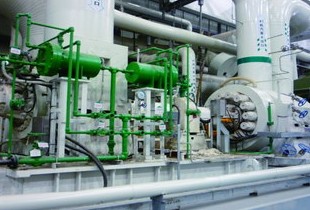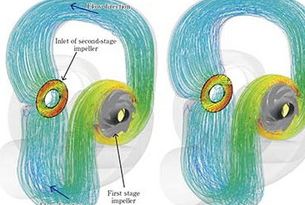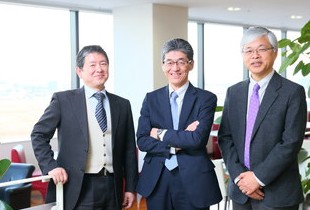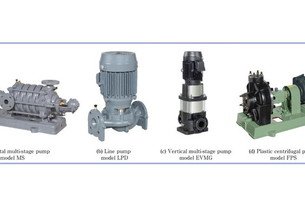Issue No. 258〔New Products & New Techniques〕
A Boiler Manufacturing Plant Making Full Use of Advanced Technologies, such as IoT and Automatic Welding Robots
Author
Yasuhisa HONDA*
Shuyin TIAN*
Xiaojun YAN*
*Ebara Qingdao Co.,Ltd.
Founded in 1992, Ebara Qingdao Co., Ltd. now designs and manufactures municipal solid waste incinerators, waste heat boilers for power generators, transfer systems, etc. It receives orders directly from municipal solid waste incineration plant manufacturers in Japan, and exports them from China to other countries. It also receives orders for projects in China and delivers incinerators and boilers. Recently, automation has been progressing in various fields of the manufacturing industry, and even the boiler manufacturing field has seen increasing demand for manufacturing plants that can flexibly meet customer needs, such as improved production efficiency and high-quality control through IoT and automation, as well as the introduction of new technologies that can respond to the added value that boilers provide. Here, we report on Ebara Qingdao Co., Ltd.’s efforts toward the IoT, automatic welding robot technology, and more.
Keywords: Boiler manufacturing, Welding robot, Multi-path/Multi-layer welding, Automatic welding, Path planning, Production efficiency
1. Introduction
EBARA Qingdao Co., Ltd. (hereinafter referred to as “EQC”) was founded in 1992 as a manufacturing plant, which mainly engaged in production design, manufacturing, and export of incinerators, waste heat boilers, transfer equipment etc., and more principally for waste incineration plants and biomass power generation plants in Japan.
Recently, high technological performance has been required of municipal solid waste incineration plants in severe price competition. Under these circumstances, boilers—the core units of plants— are confronted with needs for cost reduction, compact design, and extended life. Municipal solid waste incineration plant manufacturers are committed to the miniaturization of boilers, integration to reduce on-site installation costs, and extension of service life through metal surface treatment technologies for parts exposed to corrosive environments.
EQC has been intensely committed to improving product quality and work efficiency by introducing new technologies and equipment to meet diversifying needs.
2. EBARA Qingdao Co., Ltd.
When EQC was founded in 1992, only the Phase 1 plant was constructed, but to increase production capacity, the Phase 2 plant was built as an addition and started operation in 2008 (Figure 1).

Figure 1. Plan view of EQC
About 500 employees in total work at EQC, including some 170 office work staff members engaged in design, production engineering, and general affairs, and some 330 plant field workers.
In particular, to secure welding quality, many welders possess qualifications specified not only in Chinese standards but also in JIS standards and the Electricity Business Act. There are also personnel qualified to perform nondestructive tests, including RT (radiographic testing), UT (ultrasonic testing), and PT (penetrant testing).
EQC was granted a Class A boiler manufacturing license by the State Administration for Market Regulation in 2003 as a boiler manufacturer and is permitted to design and manufacture boilers with unlimited pressures and capacities.
In 2016, EQC obtained S and U Stamps from ASME, which allows us to manufacture boilers for countries other than Japan and China as well.
The production volume in 2018 reached about 6 000 t/y.
Also in 2000, EQC obtained ISO 9001 certification from a German technical accreditation company (TÜV). It works to earn customer trust both in China and overseas.
3. Features of main products (boilers and associated products)
The structure, shape, and size of each incinerator and boiler for municipal solid waste incineration plants is depending on the plant manufacturer and the project (Figures 2 and 3).

Figure 2. Waste heat boiler

Figure 3. Temporary assembly work of large waste heat boilers
EQC manufactures such plate-worked products, which differ depending on the project, through the process of machining of pipe and plates into parts, welding, assembly, straightening, and various inspections and tests.
4. Introducing automatic welding robots
4-1 Developing automatic welding robots
We are required to manufacture such boilers and plate-worked products of different shapes with high efficiency while ensuring quality. EQC has mechanized some welding operations, but welding has been performed with adjustments made by workers. Although the shapes of boilers are different, we considered whether it was possible to automatize welding for similar structures and repetitive welding, Automatic welding robots are developed by using sensors and programs to control welding instead of human eyes and minds.
4-2 Configuration of automatic welding robots
Figure 4 shows the configuration of the robot system.

Figure 4. Automatic welding robot system
A header (product) is set in the green area and can be rotated by the positioners installed at both ends. The robots equipped with welding machines can move on the robot rails laid in parallel in front of and behind the header.
Installed at the end of the robot arm are a laser sensor and a MIG welding torch. To absorb welding heat deformation and manufacturing tolerances, we use not only programming of drawing dimensions, but also data obtained by the laser sensor on the positions and shapes of portions to be welded, to automatically plan a welding route and then perform MIG welding accordingly.
4-3 Developing a header automatic welding robot system
The welding structure of boiler headers is fairly similar (Figure 5), although boiler manufacturers or projects are different, and because many water pipes and nozzles are to be welded to headers, we developed a header automatic welding robot system intended for header welding.

Figure 5. Header nozzle groove welding model
4-3-1 Multi-path/Multi-layer welding path planning
The number of weld layers is determined by the thickness of the welding nozzle, and multi-layer welding is carried out when the nozzle is thick. As the first layer is welded, the groove angle widens, and padding becomes insufficient only with a single path, resulting in a need to increase the number of paths to two, three, and so on. Because of this shape, it is necessary to perform multi-path/multi-layer welding.
To perform groove welding on the nozzle shown in Figure 5, determine the coordinate axes of X, Y, and Z, and plan the curve of the nozzle hole on the header side and the curves of the inside and outside of the groove on the nozzle side based on the outer diameter and thickness of the header and the outer diameter of the nozzle.
φ1: Outer diameter of the header
δ1: Thickness of the header
φ2: Outer diameter of the nozzle
δ2: Thickness of the nozzle
Curve 1: The curve of the nozzle hole on the header side
Curve 2: The curve of the inside of the groove on the nozzle side
Curve 3: The curve of the outside of the groove on the nozzle side
In multi-path welding, the angle of the welding torch is the angle represented by the blue line shown in Figure 6 in the case of a groove shape of ∠P1, P0, and P2.

Figure 6. Ideal weld bead model of groove shape
Next, as the number of layers increases, the number of paths increases as follows: one path for one layer, two paths for two layers, and so on. Thus, the locus of the welding torch is the path plan along the line shown in Figure 7.

Figure 7. Locus of welding porch
5. Features of refined header automatic welding robots
Figure 8 shows a scene of saddle welding of a header and a nozzle of the same diameter by the robot welding system.

Figure 8. Saddle welding of header and nozzle of the same diameter
The features of refined header automatic welding robots are described below.
• Header automatic welding robots are superior in work efficiency to automatic welding machines without a sensor because even if a product is roughly set, the position of the product will be detected by the laser sensor and corrected.
• Header automatic welding robots are very efficient because they can perform welding about ten times faster than manual welding.
• The shape and dimension of weld beads are fine, defects are not detected in PT testing, and high quality can be maintained in a stable manner.
6. Future policy for shifting to automatic welding robots
Besides the header automatic welding robots introduced this time, EQC also possesses a water wall automatic welding machine system, an automatic overlaying machine for water wall panels, and more. However, only about 10% of all welding operations are automated. Also, adding cameras and sensors to automatic welding robots will allow workers to perform operations more efficiently and safely. We hope to automatize a wider variety of welding systems with the aim of realizing higher efficiency and stable quality.
7. Utilizing IoT
In the shift to IoT, EQC is linking the statuses (operating time, current value, voltage value, etc.) of all welding machines used in the plants through a network to have integrated control over their data. While only centralized control of status data is put into practice at present, in the future we hope to control current and voltage values according to the welding procedure specification (WPS) and link welding data to welding control documents. Also with regard to devices other than welding machines, putting them under control may make it possible to discover issues that need to be resolved to improve work efficiency.
8. Conclusions
In this paper, we reported on the new header automatic welding robot that we have developed. Unlike plants that manufacture large volumes of identical products, EQC hopes to apply the technology described in this report and automatize a wider variety of machines to improve efficiency and quality in the manufacturing of plate-worked products that differ by project.
The shift of EQC’s plants to IoT has just started, but we are determined to use everything available to us in order to realize an AI boiler manufacturing plant.
Recommended articles
Inquiry about Ebara Engineering Review



